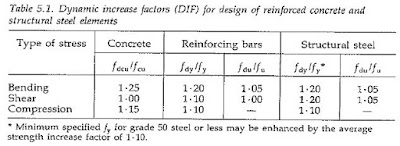The dynamic enhancement factor is used to improve/increase the strength of materials during analysis and design and when higher strain change rates are present. For example, when explosive loads are applied to a structure in a very short period of time, a greater rate of change in deformation may be observed. In similar cases, a dynamic boost factor could be considered.
This topic has already been studied extensively by researchers to consider its benefits. They found that a dynamic boost factor can have a significant impact on design. Different authors suggested different values for increasing resistance. However, it can be seen that they are in the same range.
In 2003, the U.S. General Services Administration (GSA) developed a guideline titled “Progressive Collapse Analysis and Design Guidelines for New Federal Office Buildings and Major Modernization Projects.” According to this policy, the following improvement factors can be considered.
Based on this guideline, the compressive strength of concrete and the yield strength of reinforcement can be increased by 25%. It is recommended that these values be used with great care in relation to the materials to be used in construction.
The book “Blast Effects on Buildings” by GC Mays and PD Smith also suggests a factor called “Dynamic Increase Factor” (DIF) to increase the strength of the material in analysis and design. The following table shows the values for this book.


Based on the table above, the strength of concrete, reinforcement and structural steel can be increased. Flexural, shear and compressive strengths can be increased based on the rate of change in strains as indicated in the table.
The application of these factors should be done after a comprehensive study of these guidelines.
Article Overview
You can find a summary of this article in the video below.
